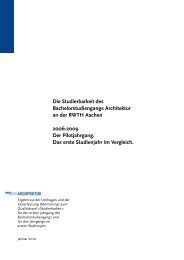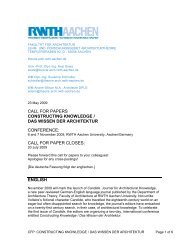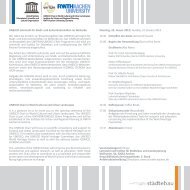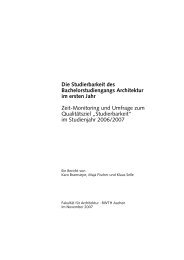Gutachten Dresden_englisch_dritte f.indd - Fakultät für Architektur ...
Gutachten Dresden_englisch_dritte f.indd - Fakultät für Architektur ...
Gutachten Dresden_englisch_dritte f.indd - Fakultät für Architektur ...
You also want an ePaper? Increase the reach of your titles
YUMPU automatically turns print PDFs into web optimized ePapers that Google loves.
84<br />
highest point of its gradient must remain below the topographical profile of the northern<br />
Elbe slope, the northern bridge head would have to be connected to a tunnel which<br />
would cross through the northern Elbe slopes.<br />
Apart from the “New Carola Bridge“, all the city bridges share certain similarities. These<br />
include the arched girders and the lookout terraces, which make the bridges an attractive<br />
place to stop and take in the sights. In this way, the bridges are special destinations unto<br />
themselves, while also providing unique views of the city and landscape. Last but not<br />
least, it is very important to note that due to the almost “trademark“ paintings of the<br />
<strong>Dresden</strong> skyline by Canaletto, in which August Bridge is almost always at the centre, this<br />
kind of bridge has meanwhile become ingrained as a “typical <strong>Dresden</strong> city bridge“ in the<br />
collective memory of Elbe Valley residents and visitors, and has become a defining image.<br />
In addition, a longitudinal view of the bridge reveals that the arched design of its mid-<br />
section serves the purpose of aesthetic accentuation rather than structural requirements.<br />
While it needs to be acknowledged that the minimum building height for the box girder<br />
construction at the „Verkehrszug Waldschlösschenbrücke“ river-crossing site can be<br />
reduced by this design, with consequent reduction of the bulk of the central part of the<br />
bridge structure, other bridges in the <strong>Dresden</strong> Elbe Valley demonstrate that the required<br />
span of 127 metres could be accomplished with less costly technical resources with the<br />
help of modern technology. Moreover, the high arch of the Waldschlösschen Bridge<br />
would be highly distinctive and set the bridge apart from other bridges in the <strong>Dresden</strong><br />
Elbe Valley, which are mostly exceedingly modest in design. The characteristic flatness of<br />
the <strong>Dresden</strong> Elbe bridges is a homage to the unique skyline of the <strong>Dresden</strong> cityscape and<br />
the grandeur of its cultural landscape.<br />
Loschwitz Bridge is one exception to this rule. Although its expressive design accentuates<br />
this Elbe crossing at least as clearly as the “Verkehrszug Waldschlösschenbrücke“ would,<br />
there are striking differences between the two bridges. The Loschwitz Bridge crosses<br />
the Elbe at a narrow point in the Elbe valley, where Loschwitz and Blasewitz lie directly<br />
opposite each other. As a result, its overall length of 296 metres is relatively short.<br />
Furthermore, the bridge is part of a technical ensemble consisting of the suspension cable<br />
railway, the cable railway and a bridge. This ensemble represents the early industrial<br />
period in <strong>Dresden</strong>‘s cityscape. It also marks the onset of the development and cultivation<br />
of tourism, an influential phase for the cultural landscape of the <strong>Dresden</strong> Elbe Valley.<br />
Although Loschwitz Bridge may not have been uncontroversial at the time of its<br />
construction, these are decisive reasons for the fact that, from today‘s point of view,<br />
a “harmonious overall impression of a cultural landscape that has evolved over many<br />
generations“ is to be found at this location in the Elbe valley.

















